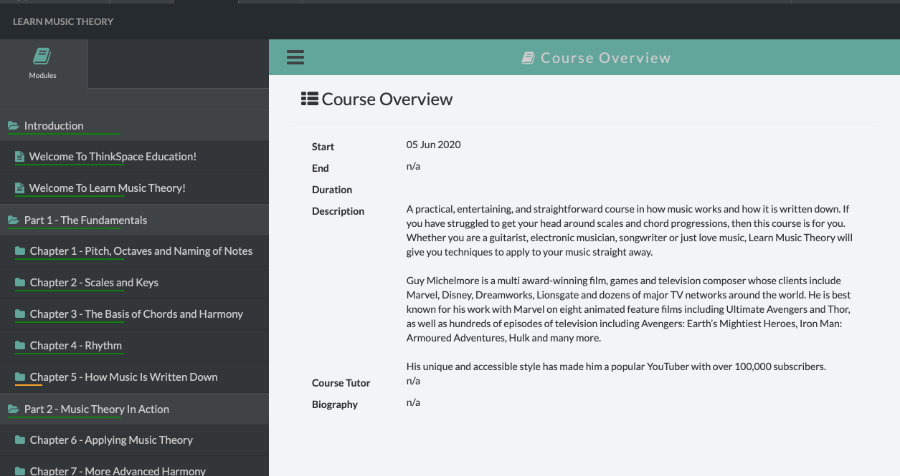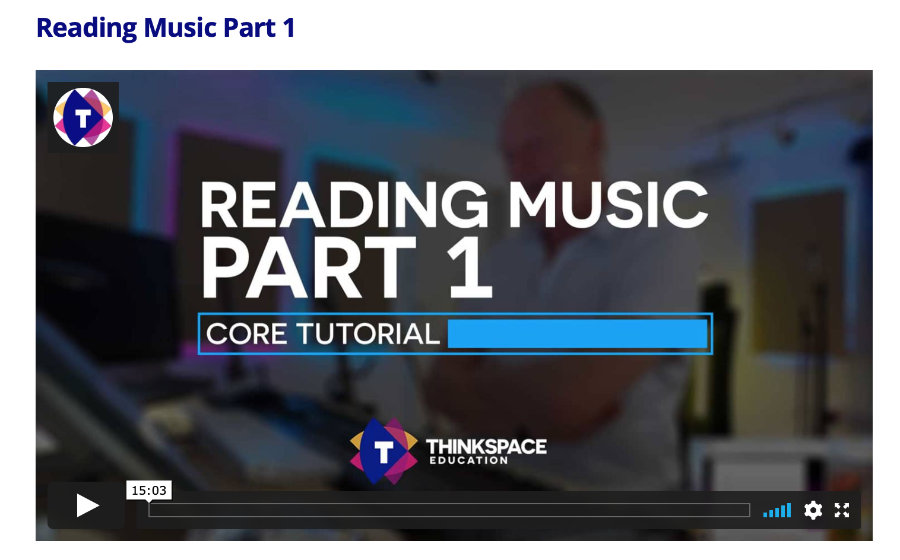When I was in college I briefly considered switching my degree from communication to music composition. But that dream was quickly squashed by a humiliating experience with an intimidating, white-haired old music theory professor. I don’t think he liked that I was a self-taught guitarist and couldn’t read music very well at the time. Oh well, his loss.
Luckily, Thinkspace-founder Guy Michelmore had a similar experience and decided to do something about it, thus creating the online course Learn Music Theory. Whether you’re a total beginner or in need of a solid refresher, his Learn Music Theory course will fill in the gaps in your knowledge in a fun and engaging manner. It’s the perfect antidote for anyone like me with a deep-seated history of music theory phobia.
OVERVIEW
Learn Music Theory is divided into two parts. Part One begins with the fundamentals, looking at pitch, octaves, scales, and keys. It’s all about how music is organized and written down. From there you will learn about chords and harmony, and then move on to rhythm and music notation.
Part Two applies lessons from the fundamentals, taking you into deeper concepts such as extended chords and progressions. You’ll also learn about different scales, modes and how music theory is used for different genres. It’s these ideas that demonstrate how music theory can make you a better musician and songwriter.

From the fundamentals all the way through to advanced concepts, this course is a complete music theory journey. By the end, you will also understand extended chromatic chords, how a full orchestral score works, and how to create a lead sheet. Over 9 hours of video tutorials explain every aspect of music theory in Guy’s distinctive and uniquely accessible style. There’s even an extra section called Music Theory for Guitarists, which was my personal favorite (thanks, Guy!).
Course notes in each lesson give you detailed, written explanations of the ideas presented in the video tutorials along with comprehensive illustrations and diagrams. Online quizzes also reinforce the lesson materials (more on that below).
COURSE STRUCTURE
The course is divided into two parts with detailed lessons/chapters within each part:
Part One: The Fundamentals
- Pitch, Octaves, and Naming notes – Starting with the fundamentals, we look at how notes are identified and organized.
- Scales and Keys – An introduction to structured harmony, looking at basic scales and how keys relate to one another.
- The Basis of Chords and Harmony – How to label the aural relationship between two notes, and learn to build chords using intervals of thirds.
- Rhythm – Identify how notes are subdivided rhythmically within a bar of four beats.
- How Music is Written Down – Music notation and how we notate pitch and rhythm, alongside performance directions such as structure and tempo.
Part Two: Music Theory In Action
- Applying Music Theory to Your Music – Putting all this in practice, we discuss how your music can benefit from learning music theory and how this helps your improvisational skills.
- More Advanced Harmony and Chords – Extended and suspended chords, jazz chord charts, key changes, and more. These are more complex harmonic techniques you can use to add additional interest to your music.
- The Wonderful World of Modes – Scales that do not fit into the traditional major and minor format. What they are, and how they work. Plus, a guide to playing these on guitar.
- Introduction to the Orchestra – A look at how orchestral instruments are used, and specific notation information you may need to know before writing for them.
- Miscellaneous – Extra information and terminology that may be of interest, such as classical structures, forms, and musical devices.
NEED TO KNOW
What I loved most about this course is the way that Guy breaks up and spoon-feeds what can often be confusing concepts into bite-size pieces. He also explains them in a few different ways in case they don’t make sense the first time around.
For example, in the fundamentals chapter, he introduces music as a series of sound vibrations at different frequencies. Then he explains the 12 tones of Western music, also known as the octave, using an animated keyboard demonstrating all the notes from middle C on up to the next C.

It turns out that the interval of an octave (e.g, C3 to C4 on a midi keyboard) is simply the doubling of a given frequency. But why then does it have a total of 12 tones when an octave has only 8? Hint: whole steps and half steps. See how this can get confusing?
Thankfully there is a supplemental “Going Deeper” video tutorial in each lesson explaining details like this more fully, which you can watch or skip depending on your level of understanding.
ONLINE QUIZZES REINFORCE LEARNING
One of the best features of the course is the interactive video quiz on Pitch, Octaves, and Intervals at the end of Chapter 1. It’s almost like having Guy give you a private lesson and gives you an opportunity to review the material and make sure you understand it.
Guy asks a series of questions and you choose the answers within the video player. If you get it right, he explains why you got it right. If you got it wrong, he explains why you got it wrong. There’s even a middle ground, where some answers are “almost right”, and of course, Guy explains why. At the end of the quiz, Guy tells you if you should go back over some of the material or if it’s safe to move on to the next chapter. At the time of this writing, the interactive video quiz is only available in Chapter 1, so hopefully, they will add more interactive video quizzes throughout the course.

At the end of the course, you’ll be challenged to take a “Mammoth” quiz consisting of 50 questions summarizing everything you’ve learned in one place. It’s a standard online quiz, so while it’s extremely valuable, it’s not nearly as engaging as the interactive video quiz in Chapter 1.
CONCLUSION
Learn Music Theory is an excellent primer or refresher for anyone interested in understanding how music theory can make them a better composer or songwriter. The curriculum is presented in a series of easy-to-understand video tutorials supplemented by comprehensive course text, illustrations, diagrams, and quizzes.
Learn Music Theory is currently available for €35 from the Thinkspace Education online store.
Pros
- Great, simple explanations of often complex subject matter
- Course text, illustrations and diagrams provide easy reference
- Online quizzes reinforce lesson topics
Cons
- Interactive video quiz is only available at the end of chapter 1
- “Mammoth” quiz at the end is a bit daunting


0 comments on “Thinkspace Education – Learn Music Theory (Course Review)”